 Ferruginous Hawk in flight with nesting materials – Nikon D810, f7.1, 1/500, ISO 640, Nikkor 500mm VR with 1.4x TC, natural light, not baited
Ferruginous Hawk in flight with nesting materials – Nikon D810, f7.1, 1/500, ISO 640, Nikkor 500mm VR with 1.4x TC, natural light, not baited
Four days ago I was on the west side of the Centennial Valley in Beaverhead County, Montana hoping to find some birds to photograph and I did find a mated pair of Ferruginous Hawks attempting to build a nest… all in low light. Ferruginous Hawks are a favorite of mine because they are large, beautiful and as their scientific name suggests, regal.
Although I would have preferred better light conditions than I had any time I have a Ferruginous in sight I will attempt to get images of them. This pair of Ferruginous Hawks puzzles me though because I have seen nesting building attempts at this same location for years and never a nest. There are power poles with one cross bar in a row that aren’t truly suitable for these hawks to build nests on, the area around the poles is flat sagebrush steppe for a long distance and the closest trees are a couple of miles away. But nearly every year I see a pair of Ferruginous Hawks in this same area looking like they are trying to build a nest. They bring the nesting materials to the power poles but always drop the material from the poles to the ground below. The odd thing is that I usually see young Ferrugs in this same area later on in the year.
I was able to create several images of this Ferruginous Hawk in flight with nesting materials over a field of sage and lupines despite the low light. I was pleased that the hawk was as sharp as it is given the conditions and that I even captured light in the hawk’s eye. I’m also glad I that in this frame it shows the sagebrush habitat where I often find these large hawks. They are another bird species for whom we need to do our best to protect the sagebrush sea in order for this species to continue to thrive.
Life is good.
Mia
Click here to see more of my Ferruginous Hawk photos plus facts and information about this species.


Ooooh.
Enjoyed the image capture.
Mia, in my experience, this species is also a cliff/hill-side nester. In river valleys they can build massive nests that are used year after year. They are definitely regal birds .. my favourite buteo.
I think Ferrugious and Rough-legged hawks are becoming my favorites. Their coloration is outstanding.
What a beautiful image…between whites of the birds itself, the blue of the lupines and silver gray of the sage…a perfect combination…interesting behaviors, too….
I think have read that some birds will build a first nest as a kind of ‘decoy’, or possibly as a second resort should they need one. Birds are so smart and resourceful, I wouldn’t put it past them. Beautiful capture.
Could anyone give me a phonetic rendition of this bird’s name? THANK YOU!
Linda, try here so you can hear it too: Ferruginous
Could anyone give me a phonetic rendition of this bird’s name??
I like the habitat aspects of this one and the slight panning blur.
Regal bird in royal setting.
Beautiful photo, Mia. That hawk is very regal.